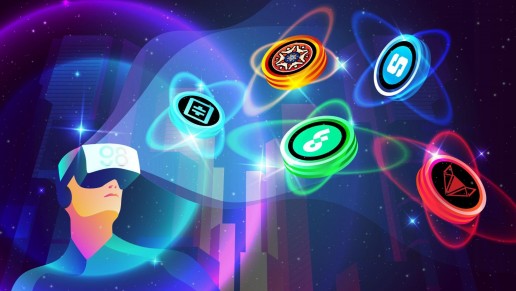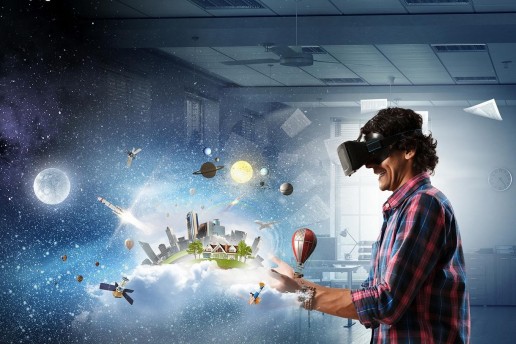The emergence of VR devices, blockchain and AR has given the metaworld a boost. Moreover, the unprecedented growth of cutting-edge technologies in the gaming industry that offer immersive gameplay not only gives us an idea of what the metaworld will look like but also indicates that we are closer than ever to creating our virtual world. Plus, we have all heard about Mark Zuckerberg’s creation of a metaverse. He wants to make a semblance of the virtual world found in science fiction novels. Had it succeeded, the metaworld would change the way people live and work. And to appreciate such a complex concept and its role in our lives, let’s understand the basics of the metaverse, its pros, cons, and its history. Let’s go!

The Metaverse is… In Simple Words
The metaverse is a new augmented reality in which we can virtually gather and discover spaces that are inaccessible to us in the real world. The metaverse can also be seen as the next generation of the Internet.
Moreover, it is described as a shared virtual world where a person (or rather their hologram or digital avatar) can, among other things, go to school and work, play games, attend concerts, store, and do other normal real-world activities. Let’s summarize: according to the online dictionary by Merriam-Webster, a metaverse usually refers to the concept of a highly immersive virtual world where people gather for specific purposes. This notion, combined with its dominance among social networks, opens the door to new and larger areas.
Although today’s metaverse is primarily focused on gaming platforms, there are other variations of it. These include:
- workspace,
- social media,
- events,
- e-commerce,
- investments, etc.
The concept of metaverses is not new, but interest in it increased dramatically after Facebook entered the market of metaverses and caused a stir. That hype led to a surge in interest and investment in the metaverse. The possibilities of the metaverse are much wider and richer than just games and entertainment.
Possibilities of a Metaverse
At first, the primary concepts of the metaverse were strictly idealist. Today’s metaworld is different. It is mainly focused on communication, which often takes place in the form of games. The metaverse offers new experiences in an open world, as well as new ways of meaningful communication in today’s digital reality. It will be possible to access the metaworld through virtual reality. No need to type on a keyboard or look at a monitor, just watch everything through a virtual reality helmet or smart glasses and motion tracking devices will allow you to move freely in this space. You can interact with other people and even objects.
So, there is an opportunity to participate in a variety of activities and keep in touch with other people through games. Plus, users are both players and developers at the same time. These games are supported by a virtual economy based on the real world. With this feature, you can find new ways to profit through virtual goods, digital stocks, etc.
Although much of the metaverse currently revolves around games, it offers users much more in terms of artificial intelligence, versatility, and utility. These include entertainment, art and culture, shopping, and economic opportunities. Users will have the ability to interact directly with public figures and celebrities, attend virtual concerts, games, graduation ceremonies, and festivals. What’s more, they will always have the virtual world at their fingertips.
A Brief History of the Creation of Metaverses
The idea of a metaverse is over 20 years old. And despite this long time, it only recently began to be actively discussed. This concept was first heard about in 1994 in the book ”Snow Crash” by Neal Stephenson. Metaworld, according to Stephenson, is the next stage in the development of the Internet. By this is meant a common digital world, combining physical, augmented, and virtual reality.
A bit later, the company Activeworlds launched Active Worlds, an online virtual reality. It was based on the metaverse that was mentioned in ”Snow Crash”.
And since that time, large companies have taken to creating three-dimensional virtual worlds, applications, and various games. These platforms provide users with virtual avatars that they can interact with, play with, and buy items in a virtual environment using digital currency and bounties.
Similar technology has also been introduced at educational institutions in the United States, including Stanford University, Louisiana State University, and many others.
With the development of the metaverse, we have every chance to freely overcome cultural barriers, differences between countries, entire nations, and even the laws of physics.

No Boundaries with the Metaverse
Back in the last century, computers were something amazing and it seemed that it was the destiny of only professional and unique people. Now almost everyone uses the Internet and makes the best of it. Computers are already common and not interesting for people. They want something new and unreal in every sense. Based on the logic of rejection and full acceptance of novelty, the developers came up with the concept of the metaverse.
The metaworld should become the next stage in the development of computer technology. They will become as simple and convenient for people as possible. From this follows the main feature of the metaverse. It is the complete obliteration of borders. Internet sites, social networks, messengers, games, and applications will merge into one big virtual world. And this virtual world will become an extension of the real one. But is it right? Do you want that? And what are the possible consequences? The answers are up to you.
Why Do We Need a Metaverse?
The digital world still exists as if in a separate reality behind a glass screen that humans cannot touch. This makes it difficult to interact with information technology.
This situation reduces engagement. Despite the efforts of professionals, people still find it difficult to use computer programs and online services.
Using computers is not only difficult, but it is also harmful to our health. We can get many diseases, from obesity and depression to serious syndromes. Gadgets slow down children’s development. Once they get a smartphone, they spend less time interacting with real objects and communicating with people in person, causing the neural connections in their brains to grow slower than they need to.
The metaverse will allow people to stop sitting in front of screens and start manipulating three-dimensional objects, talking and physically interacting with each other in a virtual environment. In this way, even children will be able to play with each other, communicate and develop. Students will be able to have a simple and accessible learning process. Moreover, there is a possibility that some professions will completely go into remote mode.
People with disabilities will be able to attend concerts, exhibitions, museums, clubs, schools, and universities not in such a limited format as now, but by immersing themselves fully in these virtual locations.

No Boundaries with the Metaverse
Back in the last century, computers were something amazing and it seemed that it was the destiny of only professional and unique people. Now almost everyone uses the Internet and makes the best of it. Computers are already common and not interesting for people. They want something new and unreal in every sense. Based on the logic of rejection and full acceptance of novelty, the developers came up with the concept of the metaverse.
The metaworld should become the next stage in the development of computer technology. They will become as simple and convenient for people as possible. From this follows the main feature of the metaverse. It is the complete obliteration of borders. Internet sites, social networks, messengers, games, and applications will merge into one big virtual world. And this virtual world will become an extension of the real one. But is it right? Do you want that? And what are the possible consequences? The answers are up to you.
Why Do We Need a Metaverse?
The digital world still exists as if in a separate reality behind a glass screen that humans cannot touch. This makes it difficult to interact with information technology.
This situation reduces engagement. Despite the efforts of professionals, people still find it difficult to use computer programs and online services.
Using computers is not only difficult, but it is also harmful to our health. We can get many diseases, from obesity and depression to serious syndromes. Gadgets slow down children’s development. Once they get a smartphone, they spend less time interacting with real objects and communicating with people in person, causing the neural connections in their brains to grow slower than they need to.
The metaverse will allow people to stop sitting in front of screens and start manipulating three-dimensional objects, talking and physically interacting with each other in a virtual environment. In this way, even children will be able to play with each other, communicate and develop. Students will be able to have a simple and accessible learning process. Moreover, there is a possibility that some professions will completely go into remote mode.
People with disabilities will be able to attend concerts, exhibitions, museums, clubs, schools, and universities not in such a limited format as now, but by immersing themselves fully in these virtual locations.
Is the Metaverse Suppressing the Real World?
Figuring out how the metaverse is already replacing the real world is easy enough if we just look a little deeper into the usual concepts.
The first thing we can talk about is the COVID-19 crisis. It has literally caused a massive growth of almost all online resources related to the metaverse. This includes blockchain services, the gaming industry, NFT, and the like. Just look at bitcoin. The value of it and many other cryptocurrencies are showing an upward tendency.
Moreover, many real-world events such as school, university, music concerts, business meetings, auctions, fundraisers, and even marriages have started to take place in the virtual world.
Simulation artists skilled in creating restaurants, galleries, offices, and other facilities in the metaverse can earn thousands of dollars for designing a single building. NFT artists organize virtual events to showcase their artwork and even charge admission for visitors to such events.
In theory, the metaverse is an open world where our age, gender, race, or religion doesn’t matter. This is largely because we can hide who we are behind the avatars. People can trade, collaborate, create assets, invest in virtual real estate, customize their world, swap personalities, and achieve many goals. After all, all you need is an Internet connection, a smartphone, and a VR headset.
Are there any Problems with Immersion in the Metaverse?
The human being is capable of seeing, hearing, feeling, smelling, tasting, and feeling his/her position in space. The metaverse can only partially cover the first three senses right now. These are vision, hearing, and touch. The devices for this, unfortunately, do not work perfectly.
VR headset users complain of nausea, dizziness, and headaches. The slightest discrepancy between the visible picture and the actual position and movement of the body can cause stress to the organism.
The headset itself is not very comfortable. VR glasses are not very heavy, but they strain the neck, put pressure on the ears and face around the eyes, and sometimes fog up the inside. Mark Zuckerberg himself admits that not many people would want to spend hours in such conditions. AR systems, which are still being refined, can fix this. VR or AR users need to actively move their arms in the air with their weight. Not many people are likely to be able to do this for hours on end during the workday or find it comfortable. Without the full tangibility of virtual objects, the metaverse cannot be a comfortable playground for users.
Tactile gloves and whole suits can be bought now, but they only solve the problem by half. Besides, such devices are rather expensive.
There are also issues of physical safety. In a VR helmet, people do not see the real objects around them, so even a few steps forward can lead to injury or death.
For maximum realism, virtual reality will need to be adjusted to the capabilities of the senses. Moreover, it is still unclear how the brain and psyche will react to a long systematic stay in virtual reality or the use of augmented reality.
The Metaworld and Enhancing Users’ Lives
The digital world is highly fragmented. Websites, services, games, to say nothing of local applications, exist in their isolated worlds. Many programs try to be a separate ecosystem and create their metaworld. The same online game sometimes falls apart into separate virtual worlds when run on different hardware platforms, making it impossible for users, like PlayStation, to play with each other.
We have to make dozens or even hundreds of accounts to cover all sources of information and entertainment. This is time consuming and can be problematic even for experienced users. Sometimes we need to quickly find something or someone, and the website or service does not even let us browse through the pages.
Social networks and messengers have partially reduced fragmentation. They replace chat rooms, forums, payment systems, job exchanges, trading platforms, offering it all as a single set of services.
Here the metaverse should transparently unite all existing and future ecosystems into one virtual world. It turns out that all ecosystems and worlds of the metaverse will be in one space. It will be much easier for people to monetize any of their actions or objects.
What Is the Bottom Line with the Metaverse’s Effect on Us?
Metaverse is an exciting adventure. No single organization can or will own the metaworld, but companies and businesses will be able to use and interact with the metaverse just like everyone else. What is more, this platform will operate using blockchain technology, which protects against fraud and other security threats. Plus, the metaverse will actively interact with cryptocurrencies. Overall, many points of contention still need to be worked on. The metaverse provides quite a lot of opportunities for people with disabilities. It also makes it easier for us to learn, work, communicate, and interact with each other. Also, companies can now get ahead of the competition by embracing the digital future. The metaverse can be seen as another stage of digital transformation, as well as an opportunity to change your brand.